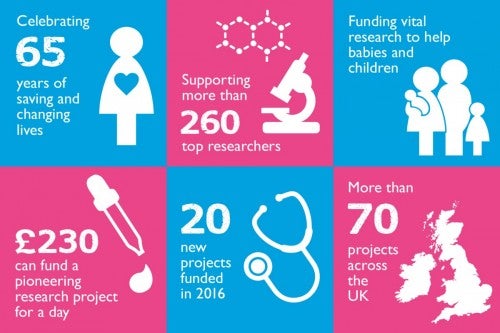
1952 – 1962: eradicating polio
The charity was founded in 1952 by Duncan Guthrie as he sought to find a cure for polio, which his daughter Janet was afflicted with. In the early 1950s, 8,000 people were paralysed by polio each year in the UK. The charity was originally called The National Fund for Poliomyelitis Research and changed its name to The National Fund for Research into Poliomyelitis and Other Crippling Diseases in 1960. Its funding helped to develop the first oral polio vaccine which successfully eradicated new cases of the disease in Britain.
A large share of the Action Medical Research polio funds went to Professor George Dick and his team at Queen’s University in Belfast. The team of researchers tested and develop two polio vaccines for use in the UK. The injectable Salk vaccine was first introduced in 1955 and the oral sugar cube Sabin vaccine was introduced in 1962.
1967 – 1981: ultrasound and the Matrix chair
In 1967, the charity changed its name to The National Fund for Research into Crippling Diseases.
During the 1970s and 1980s the charity supported a number of projects working to develop safe ultrasound techniques for monitoring babies during pregnancy. In 1978, the charity funded Professor Ian Donald’s work to develop a pregnancy ultrasound technique by awarding him and his colleagues at the Western General Hospital, Edinburgh a grant for a real-time scanner to assess babies. In 1981, the charity provided further funding for a videotape recorder system enabling the doctors to study a baby’s movement in 2D for the first time.

US Tariffs are shifting - will you react or anticipate?
Don’t let policy changes catch you off guard. Stay proactive with real-time data and expert analysis.
By GlobalDataAlso in the 1980s, Action Medical Research supported researchers at University College London as they developed the award-winning Matrix seat to help severely disabled children with their posture. The seat can be closely fitted to a child’s body shape and avert pressure sores.
1992: protecting children from meningitis
Thanks to the introduction of the Action Medical Research funded Hib vaccine in 1992, meningitis in children under five years old fell by 98% in the UK.
2003: official title
The charity was renamed Action Medical Research in 2003.
2009: mapping brains
In 2009, Action Medical Research awarded over £148,000 to researchers based at Imperial College London so they could map brain development in healthy new-borns. In 2010, with support and additional funding from the charity, the same team received a grant of over £1m from the Engineering and Physical Sciences Research Council to build upon their brain map research and develop a computer programme to automatically identify areas of abnormal brain development on MRI scans, which could aid in the prevention of future disabilities for a child.
2018: new grants awarded for future research
In September 2018, Action Medical Research announced seven new grants with a total value of just over £1.2m. The grants have been awarded to universities and hospitals in the UK which are researching how to help sick babies and children.
The new studies started in late 2018 or early 2019 and include a study using brain scans to help identify babies at higher risk of developing autism or ADHD as well as research to help children with juvenile arthritis.
2019: Charity of the Year
Action Medical Research is the BioIndustry Association (BIA) Charity of the Year for 2019. The BIA will work with the charity to fund its ongoing research intends, and to promote links with biotech companies carrying out research and development.



